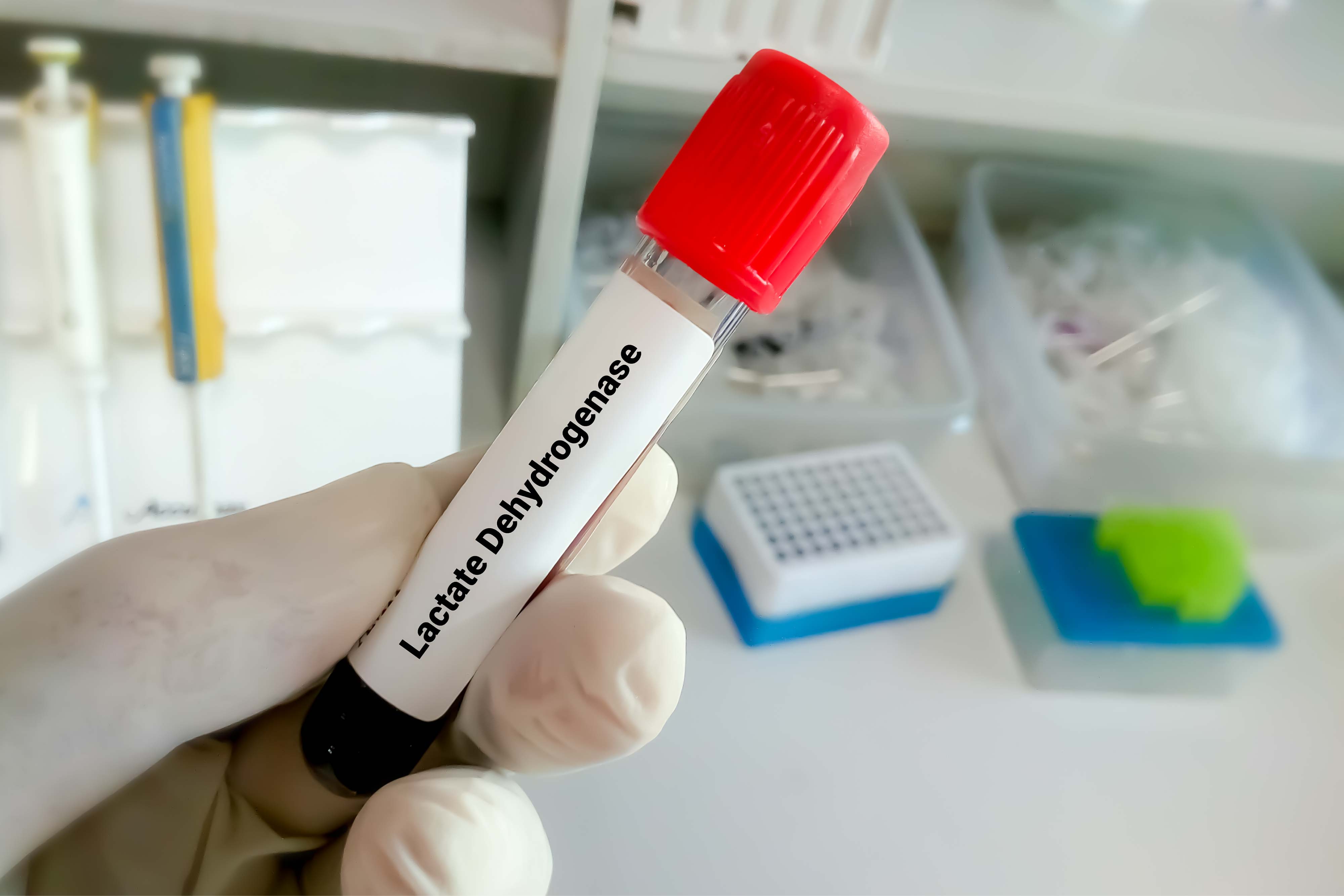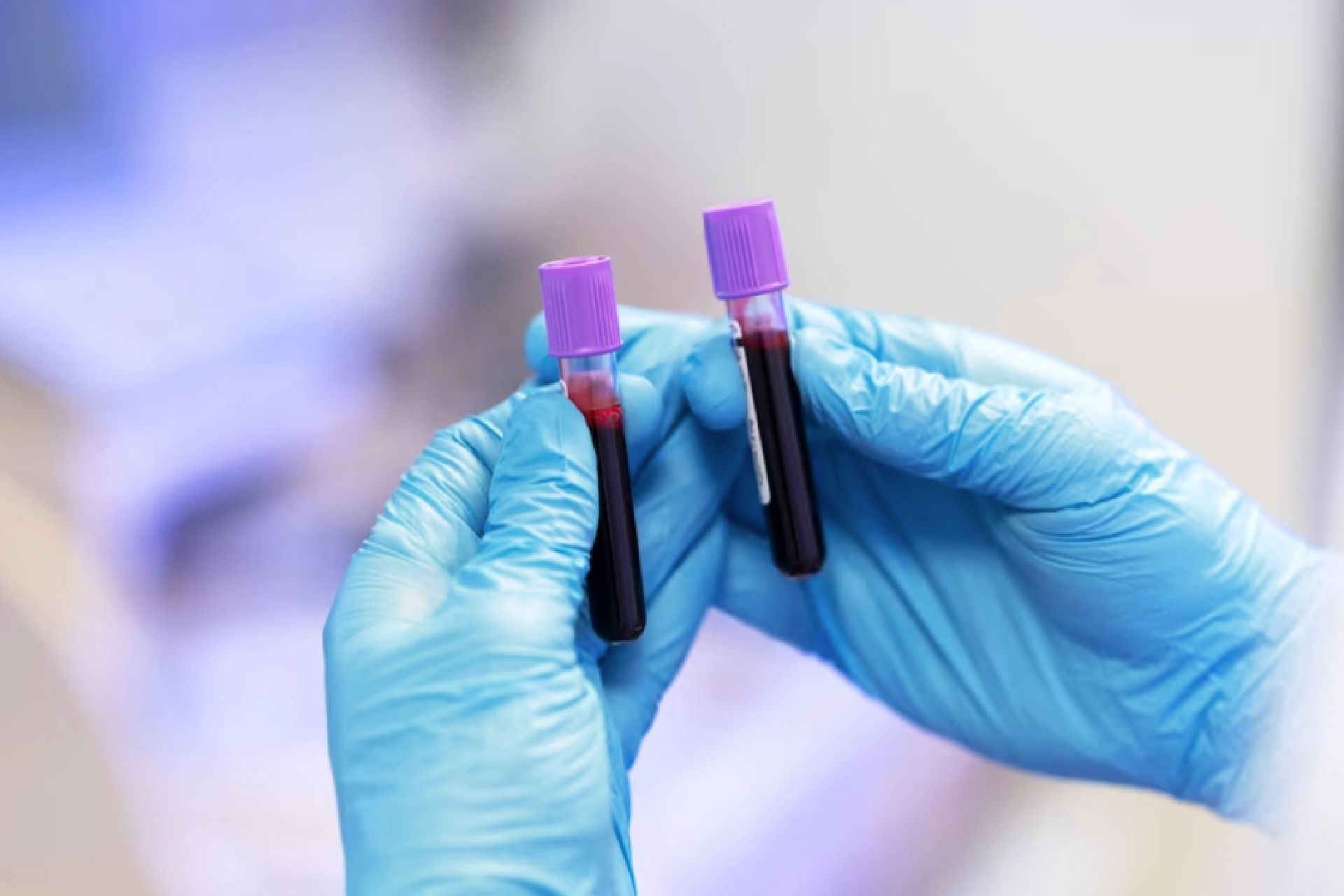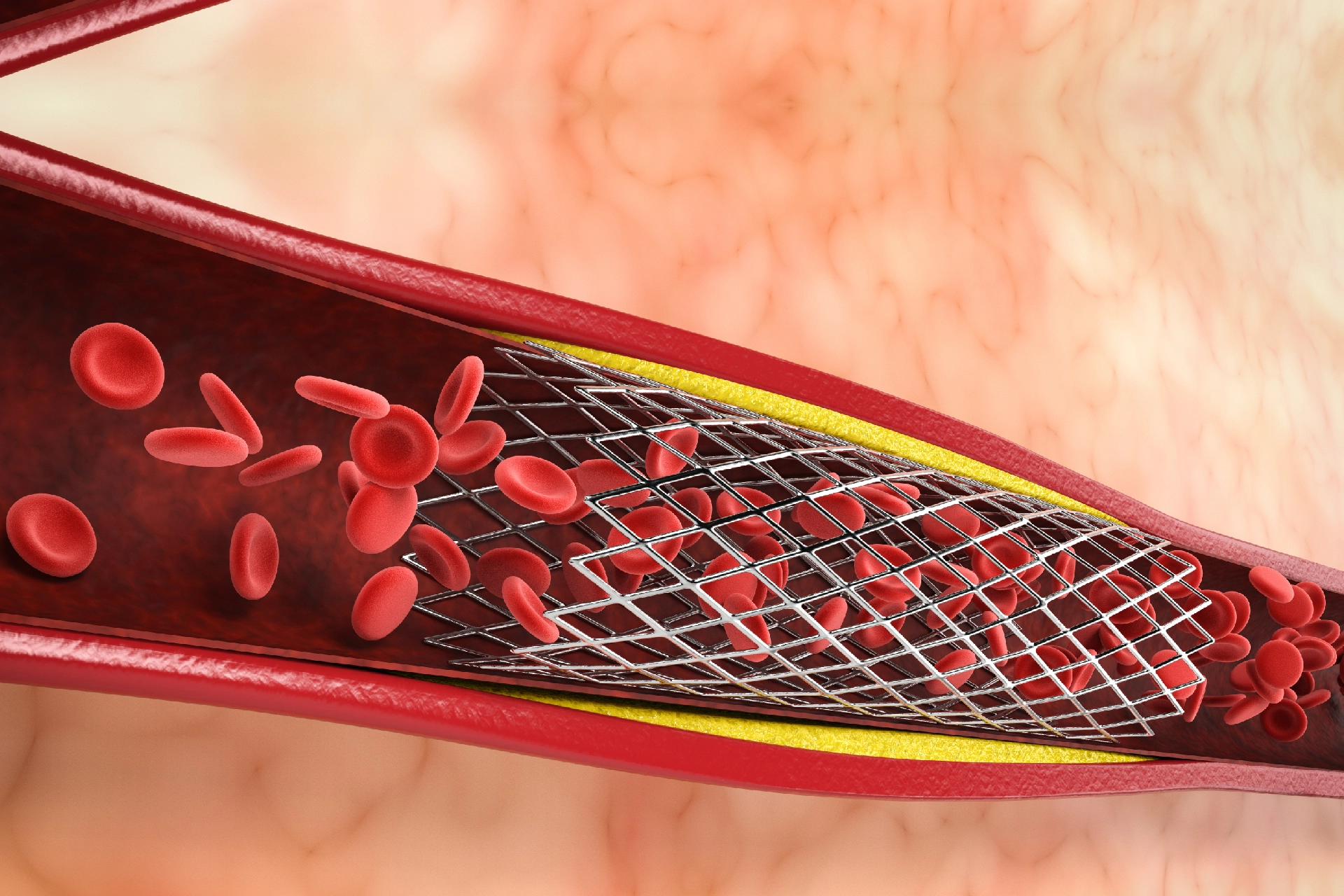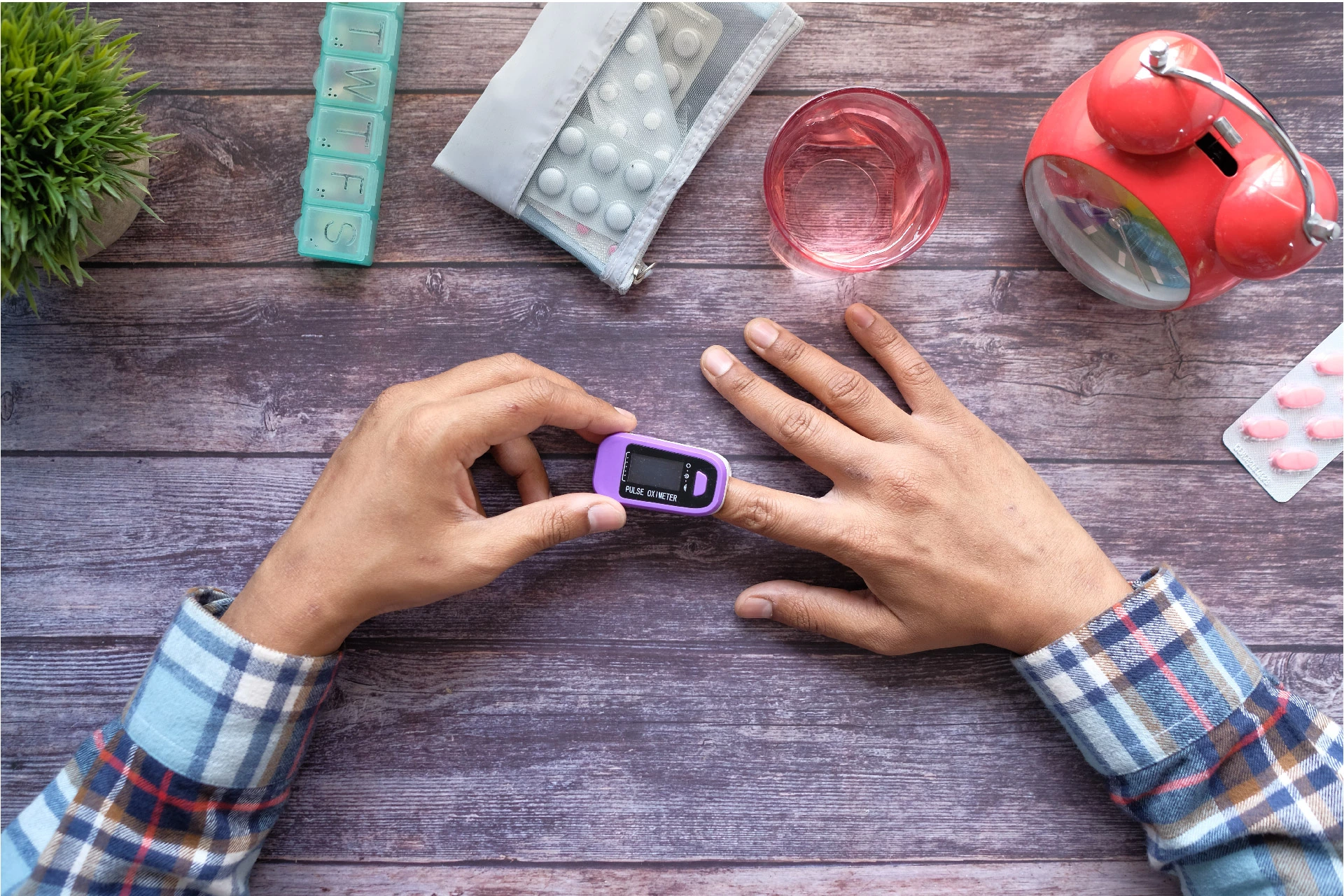Health Tests | 9 min read
LDH Test: Types, Procedure, Cost and Results
Medically reviewed by
Table of Content
Synopsis
LDH test is about detecting the enzyme's level in the body fluids, including blood, an indicator of tissue and cell damage due to underlying medical conditions. While it helps diagnose diseases, it can also help monitor certain cancers and their response to treatment. This article discusses different aspects of LDH and the test's significance.
Key Takeaways
- LDH is an essential enzyme helping the body's sugar metabolism produce energy
- Abnormal levels, whether high or low, indicate the extent of tissue and cell damage to diagnose the underlying diseases
- The testing procedure is relatively simple and undertaken in conjunction with other diagnostic tests for best results
Lactate Dehydrogenase (LDH) is an enzyme that converts sugar into energy for your body cells. Thus, LDH is present in different body organs, including the heart, liver, pancreas, kidneys, lymph tissues, blood cells, and even skeletal muscles. Though its presence in your body tissues is regular, high levels indicate different diseases and medical conditions. But how do you determine its level? LDH test allows doctors to evaluate the enzyme levels in your body and form an opinion about your health condition. So, let us understand more about what the LDH test means.
Understanding LDH Test
LDH lab test is a benchmark for measuring the enzyme level in your body tissues from blood samples or fluids extracted from the chest, central nervous system, or abdomen. The analysis of the results indicates the malaise, including certain cancers, depending on the extent of tissue damage. LDH levels in the bloodstream rise when you suffer from illness, showing acute or chronic cell damage. Contrarily, abnormally low LDH levels are rare and are not harmful. That leads us to explore the purpose of the LDH test in the first place.
Purpose of LDH Test
Your healthcare consultant interprets the LDH blood test outcome with various other tests to diagnose or monitor multiple diseases or medical conditions. For example, the LDH test provides information about the tissue and cell damage due to illness or disease compared to the LDH normal range. So, you can summarize the purpose of the test as follows:
- To primarily diagnose diseases and medical conditions that cause cell damage
- To assess the severity of specified cancers and monitor the patient's progress during treatment
- To evaluate the abnormal accumulation of fluids in the body
Simply put, various situations demand the performance of LDH blood tests, which raises the question of what it measures. So, let us find out.
What Does the LDH Test Measure?
Replace old cells with new cells is the body's normal physiological phenomenon of releasing lactate dehydrogenase during the process. LDH is a type of protein called enzymes that keeps flowing into the bloodstream and other body fluids as cell renewal is a continuous process.
However, when the tissue and cell damage is faster than usual, some LDH leaks from the damaged cells into the bloodstream. As a result, its level rises higher than the LDH test normal range depending on the illness causing cell injury. In addition, the doctor may suggest related tests to determine levels of different LDH isoenzymes in the blood. Isoenzymes are LDH subtypes that differ in structure based on their origin, yet assessed in the LDH blood test are:
- LDH-1: Heart and RBC (red blood cells)
- LDH-2: High concentration in WBC (white blood cells)
- LDH-3: Highest in lungs
- LDH-4: Highest concentration in kidneys, pancreas, and placenta
- LDH-5: Liver and skeletal muscles

When Is an LDH Test Necessary?
LDH test is often necessary when your healthcare consultant suspects an acute or chronic condition is causing damage to your tissue. For example, heart, lung, kidney, and liver damage needs the test. In addition, when acute conditions occur suddenly due to infections, organ failure, or drug reaction, you need the test. On the other hand, chronic conditions develop gradually, and the periodic LDH assessment helps monitor conditions like anemia and liver diseases.
Moreover, other tests supplement the results of the LDH tests, helping diagnosis, the prognosis of certain cancers, disease progression, and response to treatment. Since LDH is a non-specific marker for tissue damage, many circumstances prompt its use. However, its presence in different body cells indicates many medical conditions with elevated levels. Some critical reasons are:
- Blood flow inadequacy
- Stroke or cerebrovascular accident
- Certain cancer types
- Heart attack
- Hemolytic anemia
- Liver disease, including hepatitis
- Muscle injury and muscular dystrophy
- Pancreatitis
- Abuse of alcohol and drugs
- Sepsis and sepsis shock
- Infectious mononucleosis
LDH Test Procedure
Your healthcare provider advises LDH tests alongside other tests depending on the clinical evaluation and study of symptoms. Collecting blood samples is the most common test practice, but extracting fluids from the chest or central nervous system is not uncommon. But, the sample collection depends on the source and may require proper healthcare infrastructures like clinics, labs, and hospitals. However, home collection precludes samples of lactate hydrogenase. So, the body fluids needed for LDH testing besides blood samples are:
- Cerebrospinal fluid (CSF) testing from the brain and nervous system
- Pleural fluid testing from the chest cavity
- Peritoneal fluid analysis from the abdomen
Getting Ready for the Test
The test does not require any preparation for LDH blood sample collection. But collecting other bodily fluids may need readiness, especially if you are on medication. So, your doctor may suggest temporary withdrawal of certain medicines until the sample collection, as listed below.
- Anesthetics
- Aspirin
- Clofibrate
- Fluorides
- Colchicines
- Cocaine
- Mithramycin
- Procainamide
- Statins
- Steroids, including hydrocortisone and prednisone
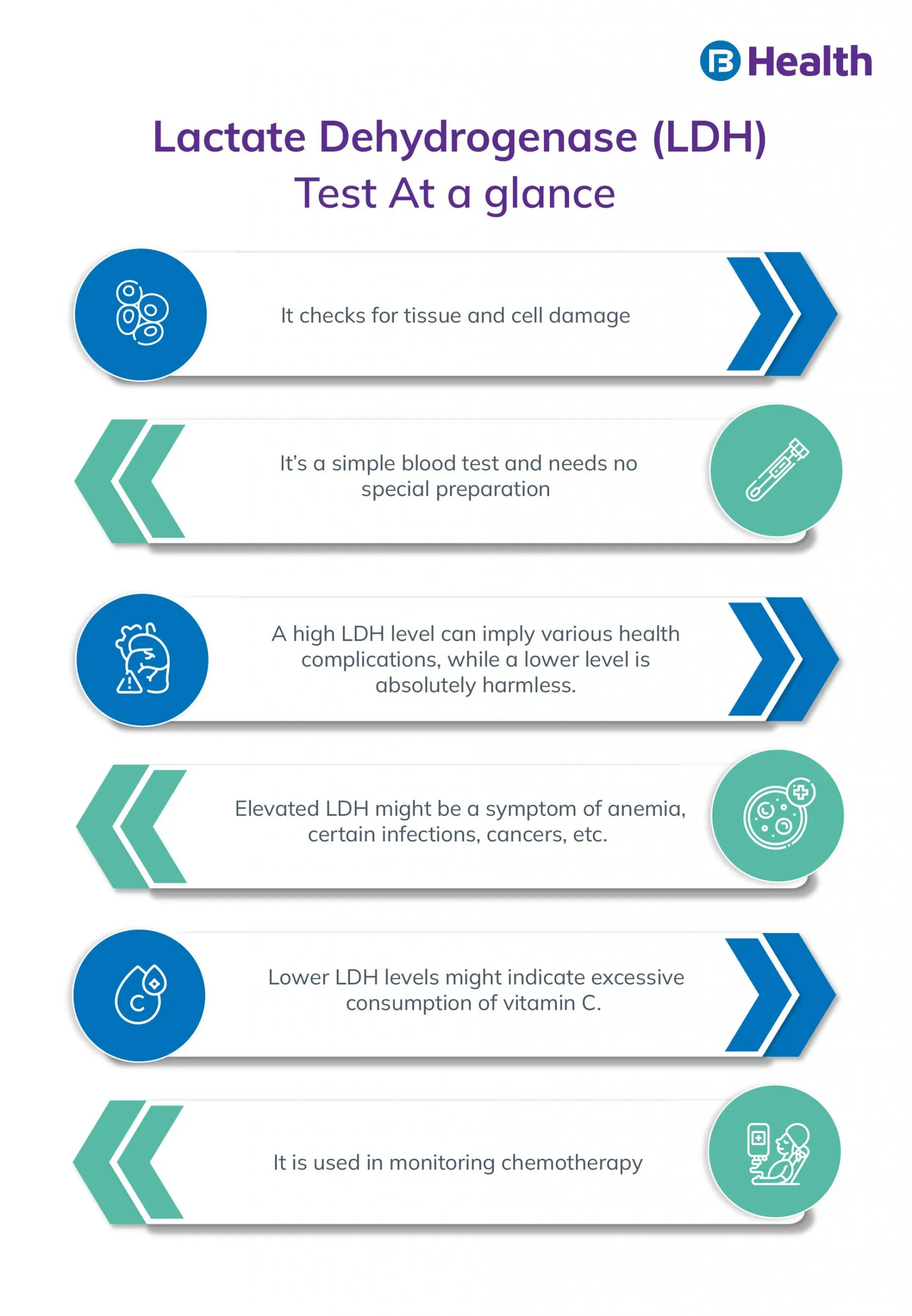
Sample collection for the test
The nurse or the healthcare provider draws a small amount of blood from a vein in your arm. Before extracting the blood, the nurse fastens a tourniquet to your upper arm to make the vein visible. Then, the needle pierces the vein through the sterilized skin to draw blood into the attached collection tube. The collection procedure takes less than a minute with a stinging sensation. But, extracting fluid from other body parts needs special equipment and additional care.
Post-test activity
A bandage or a cotton swab stops the bleeding, and the collected sample is analyzed. Drawing blood for the LDH test is a low-risk procedure; the discomfort is temporary and minimal. However, you must consult your doctor at the first sign of infection. At the same time, you need precautions to cope with the extraction of other body fluids.
Receiving the test reports
The reports take some time to prepare and are available in a few days. Then, the healthcare provider shares the test results, or you can download the information from the lab's online portal.
Additional read: How to Get a Lab Test Discount
LDH Test Normal Range
The primary LDH test outcome shows the LDH level in the examined blood sample. In addition, the results juxtaposed with the reference ranges help the doctor form an opinion. So, let us learn about the reference ranges expected of a healthy individual.
The LDH levels depend on several factors, including the individual's age and the testing laboratory. For example, infants have a much higher LDH level than older children and adults due to the heightened cell renewal activity. So, the following grid represents normal LDH ranges in the blood.
| Normal LDH level range in Units per Litre (U/L) [1] | |
| Age | Normal Reading |
| 0 to 10 days | 290 to 2000 U/L |
| 10 days to 2 years | 180 to 430 U/L |
| 2 to 12 years | 110 to 295 U/L |
| 12 Years and above | 100 to 100 U/L |
The results vary since the testing laboratory sets the ranges depending on the equipment and methodology. So, the doctor helps you understand the reading's significance. That leads us to check what the levels indicate and what the LDH test means.
Elevated LDH levels
The results may show an elevated LDH level, indicating several ailments. So, the below listed are the most critical health concerns that show high LDH levels.
Shock
A medical condition where insufficient oxygen reaches your tissues and organs.
Ischemic hepatitis
A liver disease triggered by inadequate blood or oxygen supply
Drug-induced reactions
Many drugs, including recreation, antidepressants, statins to lower cholesterol, and other prescription drugs, cause life-threatening reactions
Muscular dystrophy
A disease that shows muscle weakness and tissue loss
Acute myocardial infarction
A heart condition occurs when a blood clot impedes blood flow to the cardiac muscles.
Hemolytic anemia
It is a medical condition when the red blood corpuscles die before developing due to hemolysis.
Severe infections
LDH levels rise due to many ailments, including malaria, pneumonia, or even Covid-19
Tumor lysis syndrome
The health condition appears when tumor cells die rapidly
Cancer
Several cancers boost blood LDH levels, particularly germ cell ovarian tumors, testicular cancer, lymphoma, leukemia, and multiple myelomas, to name a few.
Lowered LDH levels
Abnormally low LDH levels are rare. But, ingesting high doses of vitamin C or E can lower LDH levels in the body. In addition, lactate dehydrogenase deficiency is a genetic disorder that interferes with the enzyme's production. But, the reduced LDH reading is not life-threatening.
Interpreting LDH Test Results from Other Body Fluid Samples
After gaining insight into the significance of LDH test findings using blood samples, analyzing the results from different body fluid samples is equally essential. They also indicate health conditions for the doctor's attention. Some vital observations are:
- Cerebrospinal Fluid (CSF): The test sample is obtained from the central nervous system to detect bacterial infections and a bleeding brain if the LDH level is high.
- Pleural Fluid: The sample extracted from the chest cavity is comparable to the LDH test outcome from blood. The results help doctors narrow down the causes and sources of pleural effusions, an abnormal fluid collection around the lungs. Thus, elevated LDH in the tested sample indicates infection, injury, cancer, or inflammation.
- Peritoneal Fluid: The abdominal fluid sample's comparison with the LDH level in the patient's blood gives several indications. High LDH levels in the peritoneal fluid indicate infection, cancer, perforation, or a hole in the bowel.
Additional read: Types of Blood Sugar Tests
The Cost of LDH Test
The cost of the test, in conjunction with other relevant tests, depends on several factors. The most vital considerations are the testing lab, the extracted samples for analysis, and health insurance providing complete health solutions to backup. In addition, you can look for lab test discounts, which is not uncommon. Thus, the below grid represents the indicative LDH test cost in some Indian cities:
| Cost of LDH test across major Indian cities [2] | |||
| Cities | Average (Rs.) | Minimum (Rs.) | Maximum (Rs.) |
| Ahmedabad | 351 | 180 | 550 |
| Bangalore | 415 | 100 | 2000 |
| Chennai | 339 | 100 | 3600 |
| Hyderabad | 315 | 130 | 950 |
| Kolkata | 348 | 200 | 900 |
| Mumbai | 339 | 150 | 700 |
| New Delhi | 381 | 150 | 2000 |
| Pune | 471 | 180 | 3600 |
LDH Test Limitations
Despite the wide use of the LDH tests to determine tissue and cell damage, the results present certain limitations. The primary is that the test results are inconclusive and need correlation with the outcome of different lab tests. Thus, if the symptoms and other test results do not indicate a disease, the reason for elevated LDH remains unclear.
In addition, certain situations can show high or low fluctuating outcomes without an underlying disease. For example, strenuous exercise and certain medications raise blood LDH levels. Moreover, improper handling of the sample can generate inaccurate results. For example, the results show low LDH levels due to the body's high vitamin C and E levels despite a disease.
Lactate Dehydrogenase (LDH) is an enzyme that breaks down sugar and distributes the energy produced to different parts of the body. Since an elevated LDH level indicates an underlying disease, the prescribed lab test does not target specific ailments. On the contrary, the LDH test supplements other diagnostic investigations if there is a similarity with the suspected medical condition. In addition to its diagnostic use, the test result helps the doctor monitor specific cancers and respond to treatment. Get in touch with Bajaj Finserv Health and get a complete health solution.
References
- https://www.healthline.com/health/lactate-dehydrogenase-test
- https://www.medifee.com/tests/ldh-cost/
Disclaimer
Please note that this article is solely meant for informational purposes and Bajaj Finserv Health Limited (“BFHL”) does not shoulder any responsibility of the views/advice/information expressed/given by the writer/reviewer/originator. This article should not be considered as a substitute for any medical advice, diagnosis or treatment. Always consult with your trusted physician/qualified healthcare professional to evaluate your medical condition. The above article has been reviewed by a qualified doctor and BFHL is not responsible for any damages for any information or services provided by any third party.
